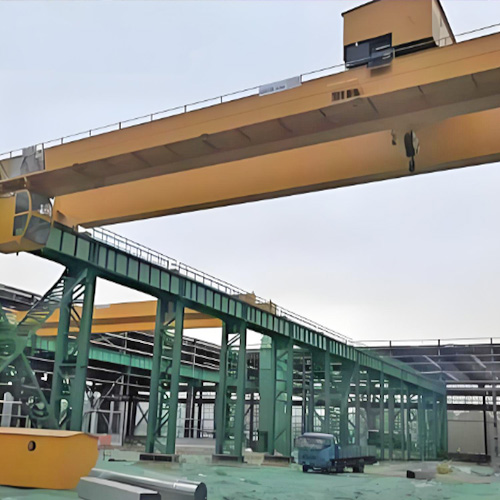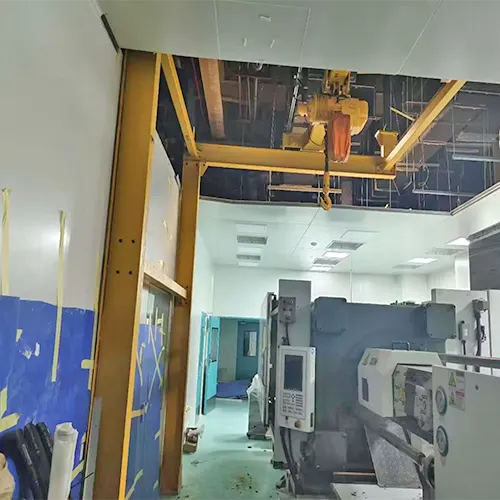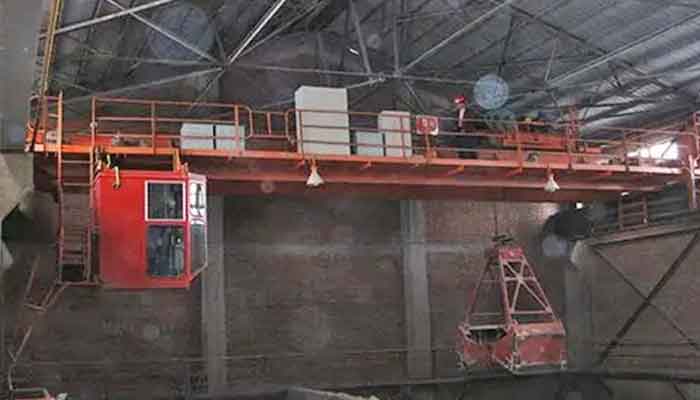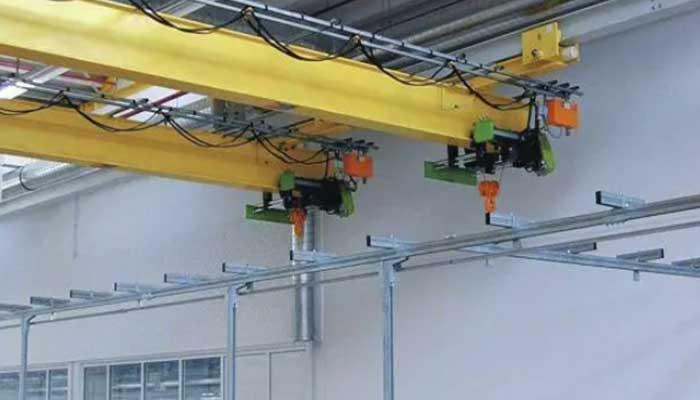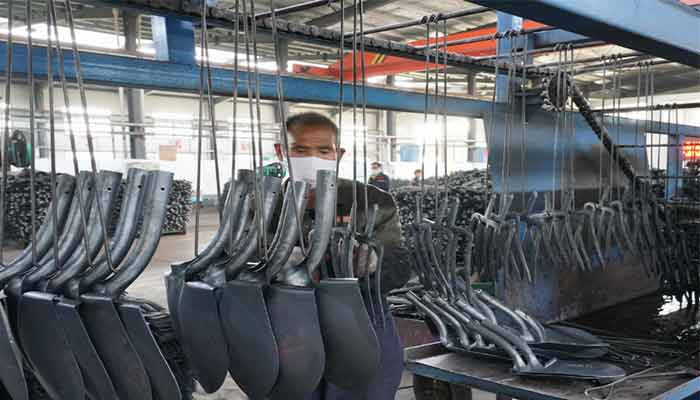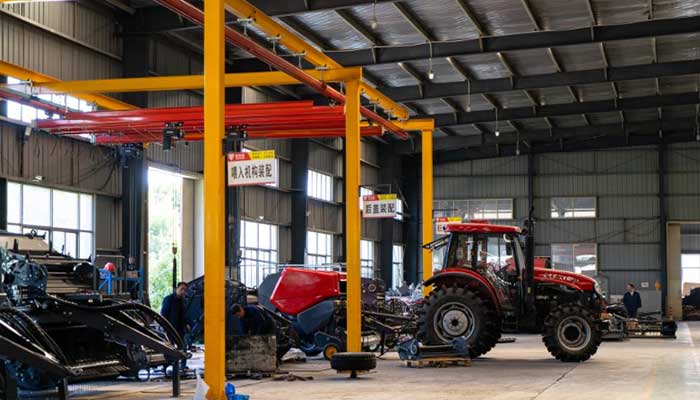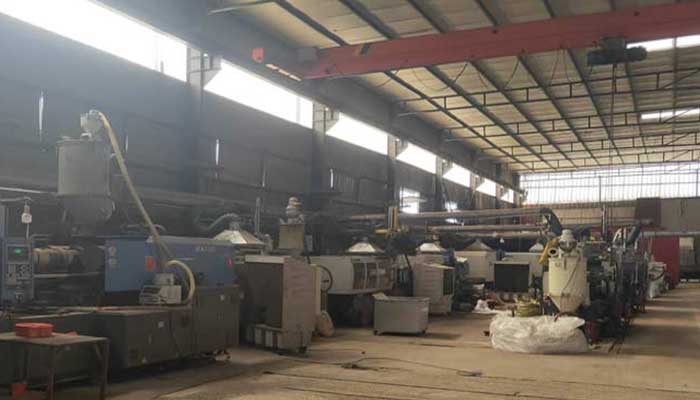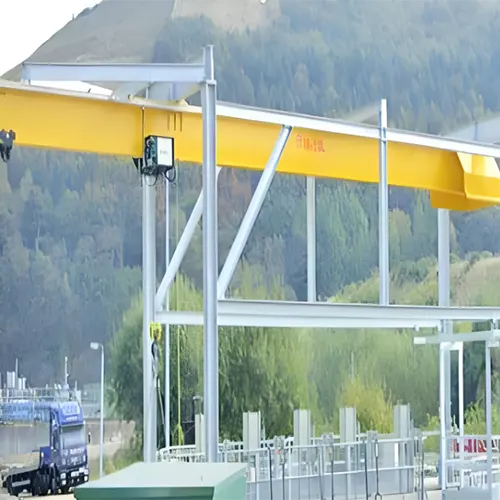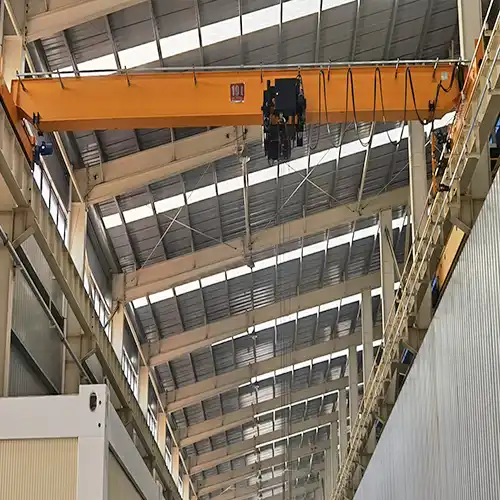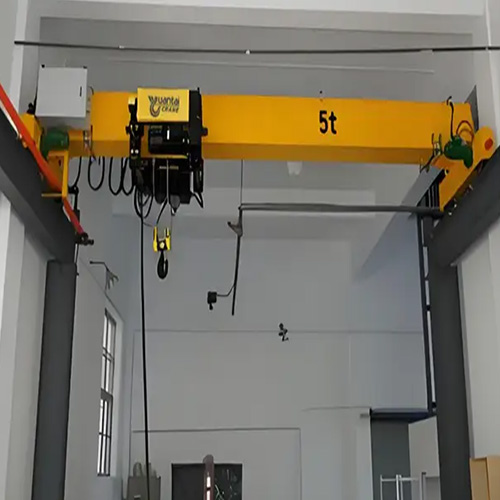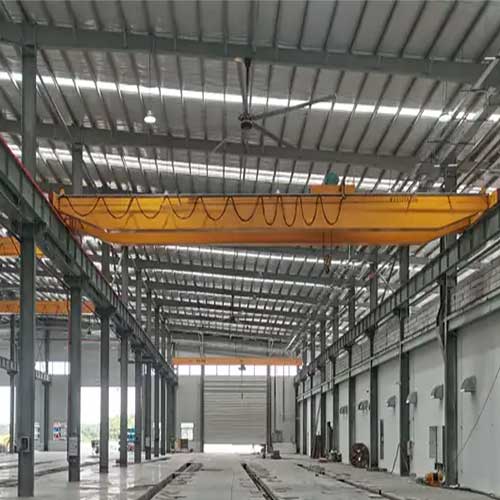5 Ton Freestanding Bridge Crane for Sale, Types & Applications
5 ton freestanding bridge crane,custom freestanding crane with single girder, double girder, top running & underhung crane design for indoor & outdoor use.
Category: 5 Ton Overhead Crane
Your Trusted 5 Ton Overhead Crane Manufacturer & Supplier
5 Ton Freestanding Bridge Crane for Sale, Types & Applications
5 ton freestanding bridge crane,custom freestanding crane with single girder, double girder, top running & underhung crane design for indoor & outdoor use.
Comprehensive Guide to 5 Ton Freestanding Bridge Cranes
A 5 ton freestanding bridge crane is a robust lifting apparatus designed to handle loads of up to 5 tons (or 10,000 pounds). Unlike traditional cranes, which rely on building structures for support, freestanding bridge cranes stand independently on their own support systems. This independence grants them unparalleled flexibility in placement and mobility within industrial settings.
Freestanding Bridge Crane with Single Girder Crane Design & Double Girder Crane Design

Single-Girder Freestading Bridge Cranes wtih Top Running Crane Design
The single-girder design of a 5 ton freestanding bridge crane features a single beam that supports the hoist and moves along the runway. This design offers simplicity and cost-effectiveness, making it ideal for light to moderate lifting applications. Single-girder cranes are known for their versatility and ease of installation, making them a popular choice for a wide range of industrial settings.
Advanteages of Single GIrder Freestanding Bridge Cranes 5 Ton
The single-girder design of a 5 ton freestanding bridge crane is characterized by its simplicity, cost-effectiveness, and versatility.
- Single Beam Configuration:
In a single-girder design, the crane is supported by a single horizontal beam (the girder) that spans the width of the runway. This beam supports the hoist and trolley mechanism, allowing for vertical lifting and horizontal movement of loads along the runway. - Simplicity and Cost-Effectiveness:
Single-girder cranes offer a simpler and more economical design compared to double-girder cranes. The use of a single beam reduces material and manufacturing costs, making single-girder cranes a cost-effective solution for light to moderate lifting applications. - Versatility and Adaptability:
Single-girder cranes are highly versatile and can be adapted to a wide range of lifting tasks and operational requirements. They can accommodate various hoist configurations, lifting capacities, and span lengths to suit specific application needs. This versatility makes single-girder cranes suitable for diverse industrial settings, including manufacturing facilities, warehouses, assembly lines, and maintenance workshops. - Ease of Installation:
The simplicity of the single-girder design contributes to ease of installation, minimizing downtime and disruption to operations during crane setup. Single-girder cranes typically require less structural support and groundwork compared to double-girder cranes, simplifying the installation process and reducing overall project costs. - Space-Saving Design:
Single-girder cranes have a compact footprint, making them well-suited for facilities with limited overhead space or confined work areas. The single beam configuration allows for efficient use of available space, maximizing the usable floor area without compromising on lifting capacity or performance. - Smooth Operation:
Despite their simplified design, single-girder cranes offer smooth and precise operation, ensuring reliable performance in lifting and material handling tasks. The hoist and trolley mechanism move smoothly along the runway, providing precise positioning and control over loads during lifting and lowering operations.
In summary, the single-girder design of a 5 ton freestanding bridge crane offers simplicity, cost-effectiveness, versatility, and ease of installation. These cranes are well-suited for light to moderate lifting applications in various industrial settings, providing efficient and reliable lifting solutions that meet the demands of modern manufacturing and material handling operations.
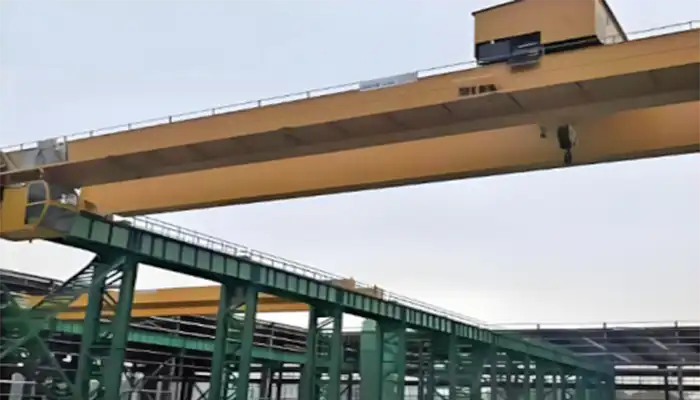
Double-Girder Freestading Bridge Cranes Design
In contrast, the double-girder design of a 5 ton freestanding bridge crane boasts two beams (or girders) that support the hoist and provide increased stability and lifting capacity. This robust configuration is well-suited for heavy-duty applications that require precise control and handling of larger loads. Double-girder cranes excel in demanding environments where strength and durability are paramount, offering unmatched reliability and performance.
Advantages of Double Girder Freestanding Bridge Cranes 5 Ton
The double-girder design of a 5 ton freestanding bridge crane is characterized by its robust construction and increased lifting capacity.
- Dual Beam Configuration:
Unlike single-girder cranes, which feature a single horizontal beam, double-girder cranes boast two parallel beams (girders) that support the hoist and trolley mechanism. This dual-beam configuration provides added stability and strength, allowing for the handling of heavier loads with greater precision and control. - Increased Lifting Capacity:
The double-girder design offers a higher lifting capacity compared to single-girder cranes, making it well-suited for heavy-duty lifting applications. The use of two beams provides additional support and structural reinforcement, allowing double-girder cranes to lift larger and heavier loads safely and efficiently. - Enhanced Stability and Durability:
The dual-beam construction of double-girder cranes enhances stability and durability, particularly in demanding industrial environments. The increased structural rigidity and load-bearing capacity of the double-girder design ensure reliable performance and long-term durability, even under continuous or high-intensity lifting operations. - Precise Control and Handling:
Double-girder cranes excel in applications that require precise control and handling of loads. The dual-beam configuration provides greater overhead clearance and improved control over load positioning, allowing for precise placement and maneuverability in tight or congested workspaces. - Versatility and Adaptability:
Despite their robust construction, double-girder cranes offer versatility and adaptability to a wide range of lifting tasks and operational requirements. They can accommodate various hoist configurations, span lengths, and lifting heights to suit specific application needs, making them suitable for diverse industrial settings, including manufacturing, construction, and heavy fabrication. - Optimized Headroom:
The dual-beam configuration of double-girder cranes allows for optimized headroom, making them ideal for facilities with limited vertical clearance or overhead space. The increased height between the beams provides ample clearance for lifting taller or bulkier loads without compromising on stability or safety.
In summary, the double-girder design of a 5 ton freestanding bridge crane offers increased stability, lifting capacity, and durability compared to single-girder cranes. These cranes are well-suited for heavy-duty lifting applications in demanding industrial environments, providing unmatched reliability, performance, and precision in material handling operations.
Freestanding Underhung Bridge Cranes
Freestanding underhung bridge cranes combine the versatility of freestanding bridge cranes with the unique configuration of underhung crane systems.
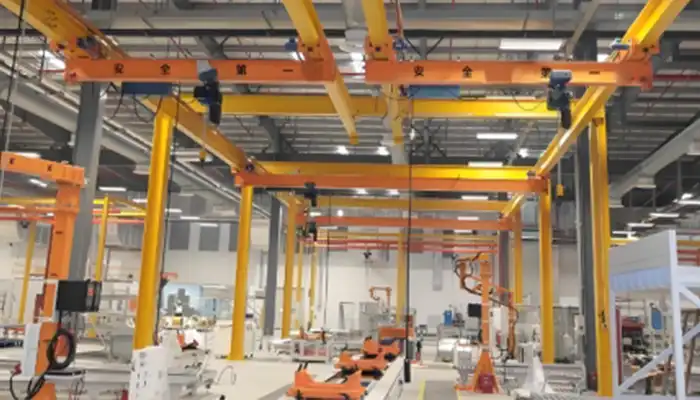
Freestanding underhung bridge crane

Freestanding bridge crane
Here's a breakdown of what these cranes entail:
Freestanding underhung bridge cranes are a type of overhead crane system that operates beneath a runway beam supported by freestanding columns. They feature a hoist and trolley assembly that travels along the bottom flange of the runway beam, allowing for efficient material handling within a designated area.
Components:
Runway Beam: The horizontal beam supported by freestanding columns, serving as the track for the hoist and trolley assembly.
Hoist and Trolley: The lifting mechanism that moves horizontally along the bottom flange of the runway beam, facilitating the lifting and movement of loads.
Freestanding Columns: Vertical support structures that provide stability and rigidity to the crane system, eliminating the need for attachment to building structures.
Features and Advantages:
Flexibility: Freestanding underhung bridge cranes offer flexibility in installation and placement within a facility, as they do not rely on existing building structures for support.
Space Optimization: By utilizing freestanding columns, these cranes maximize overhead space and floor area for other operations or equipment.
Versatility: The underhung configuration allows for precise material handling and positioning within a designated workspace, making them suitable for various industrial applications.
Ease of Installation: Installation of freestanding underhung bridge cranes is relatively straightforward, requiring minimal structural modifications to the building and reduced downtime during setup.
Cost-Effectiveness: Compared to traditional overhead crane systems that require attachment to building structures, freestanding underhung bridge cranes may offer cost savings in terms of installation and retrofitting expenses.
Applications:
Manufacturing Facilities: Freestanding underhung bridge cranes are commonly used in manufacturing facilities for assembly lines, machining operations, and material handling tasks.
Warehousing: They are suitable for warehousing and distribution centers for efficient movement of goods and inventory management.
Maintenance Workshops: These cranes are ideal for maintenance workshops where precise lifting and positioning of heavy equipment or machinery is required.
Automotive Industry: Freestanding underhung bridge cranes are utilized in automotive manufacturing plants for handling vehicle components during assembly processes.
Considerations:
Load Capacity: Ensure that the crane system's load capacity meets the requirements of the intended application.
Clearances: Adequate overhead and lateral clearances must be maintained to ensure safe operation and prevent collisions with obstacles.
Structural Integrity: Freestanding columns should be designed and constructed to withstand the loads and forces exerted by the crane system.
Maintenance: Regular inspection and maintenance of crane components are essential to ensure optimal performance and safety.
Freestanding underhung bridge cranes offer a versatile and efficient solution for material handling applications, combining the benefits of freestanding bridge cranes with the functionality of underhung crane systems. They are well-suited for various industrial environments where precise lifting and positioning of loads are required.
Freestanding Bridge Crane for Indoor Use and Outdoor Use
Choosing between a freestanding overhead crane for indoor or outdoor use depends on various factors, including the operational environment, space constraints, and specific application requirements. Let's explore the considerations for both indoor and outdoor use: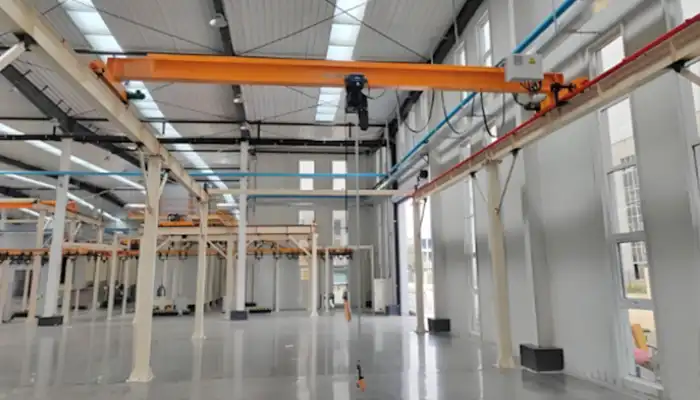
Indoor Use:
- Environmental Control: Indoor environments typically offer better control over factors such as temperature, humidity, and exposure to corrosive agents compared to outdoor settings. This can help extend the lifespan of crane components and minimize maintenance requirements.
- Space Constraints: Indoor facilities may have limited overhead space or restricted layouts, requiring compact crane designs that maximize vertical clearance and maneuverability within confined areas.
- Structural Compatibility: Freestanding overhead cranes for indoor use must be compatible with existing building structures and floor conditions. The crane's footprint, runway configuration, and foundation requirements should align with the facility's structural limitations and operational needs.
- Workflow Efficiency: Indoor overhead cranes contribute to improved workflow efficiency by providing precise control over material handling operations, minimizing manual labor, and reducing the risk of product damage or accidents.
- Noise and Environmental Impact: Indoor overhead cranes typically operate in controlled environments where noise and environmental impact are important considerations. Crane designs that incorporate noise-reducing features and energy-efficient components can help mitigate these factors.
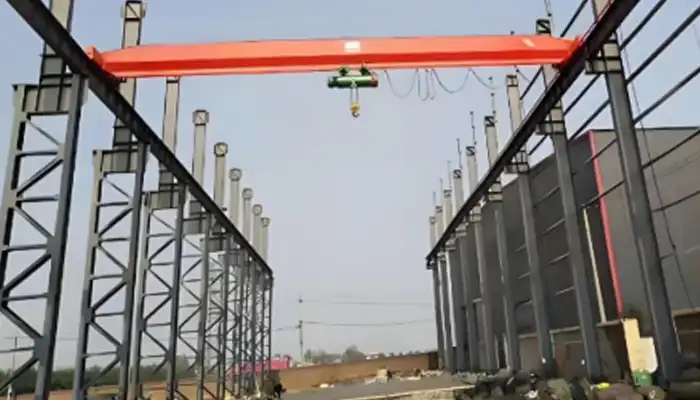
Outdoor Use:
- Weather Resistance: Outdoor overhead cranes must be designed to withstand exposure to weather elements such as rain, snow, wind, and UV radiation. Weatherproofing measures, including protective coatings, seals, and covers, help prevent corrosion, deterioration, and performance degradation in outdoor environments.
- Mobility and Portability: Outdoor overhead cranes may require greater mobility and portability to accommodate changing work locations or outdoor projects. Portable crane designs with mobile bases or trailer-mounted configurations offer flexibility and versatility for outdoor use.
- Environmental Considerations: Outdoor overhead cranes may operate in challenging environmental conditions, such as extreme temperatures, high winds, or corrosive atmospheres. Crane designs that incorporate rugged construction, corrosion-resistant materials, and advanced weatherproofing technologies are essential for reliable performance in outdoor settings.
- Terrain and Foundation Requirements: Outdoor overhead cranes may encounter uneven terrain or soil conditions that require special foundation designs or anchoring solutions to ensure stability and safety during operation. Crane installations in outdoor environments should consider factors such as ground stability, drainage, and seismic considerations.
- Durability and Longevity: Outdoor overhead cranes face greater exposure to wear and tear from environmental factors, requiring robust construction and durable materials to ensure long-term reliability and performance. Regular maintenance and inspection are essential to preserve crane integrity and functionality in outdoor applications.
Ultimately, the choice between a freestanding overhead crane for indoor or outdoor use depends on the specific operational requirements, environmental conditions, and logistical considerations of the application. By carefully evaluating these factors and selecting the appropriate crane design, businesses can optimize lifting operations and ensure safe and efficient material handling in any setting.
Semi Freestanding Bridge Crane 5 Ton , Customized Based on Your Applications
A semi-freestanding bridge crane is a versatile lifting solution that combines elements of both freestanding and ceiling-mounted crane systems. Customizing a 5-ton semi-freestanding bridge crane to suit specific applications involves tailoring the crane's design, features, and capabilities to meet the unique requirements of the intended use.
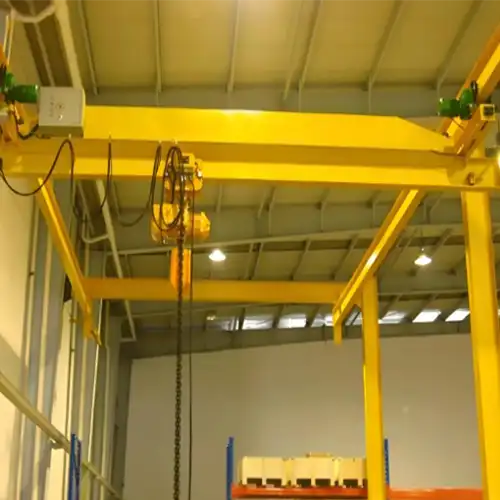
Semi free standing bridge crane
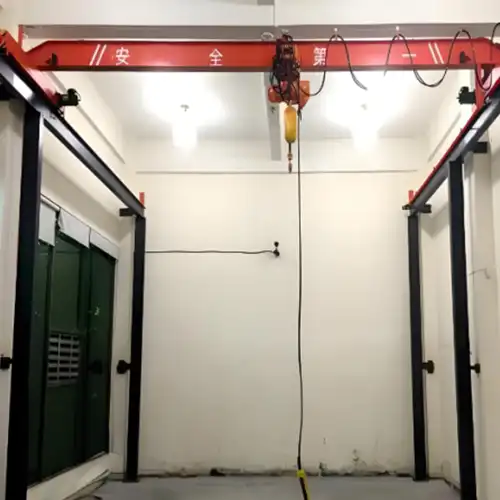
Semi freestanding bridge crane 5 ton
Here's a breakdown of the customization process:
Assessment of Application Requirements:
Load Capacity: Determine the maximum weight of loads to be lifted and moved by the crane system.
Workspace Dimensions: Measure the dimensions of the workspace, including ceiling height, floor space, and any obstructions.
Material Handling Tasks: Identify the specific material handling tasks the crane will perform, such as lifting, transporting, and positioning loads.
Operational Environment: Consider factors such as temperature, humidity, and exposure to corrosive substances that may impact crane performance.
Customization Options:
Runway Configuration: Customize the layout and design of the crane's runway to optimize space utilization and workflow efficiency within the workspace.
Hoist and Trolley System: Select a hoist and trolley system with appropriate lifting capacity, lifting speed, and control features to meet the demands of the application.
Control System: Choose a control system that provides intuitive operation, precise load positioning, and safety features such as overload protection and emergency stop functionality.
Safety Features: Incorporate safety features such as limit switches, collision avoidance systems, and warning devices to ensure safe operation and prevent accidents.
Material Handling Accessories: Select additional accessories such as lifting attachments, spreader bars, or vacuum lifters to accommodate different types of loads and materials.
Integration with Existing Equipment: Customize the crane system to integrate seamlessly with existing equipment and processes within the workspace, such as conveyor systems or production machinery.
Design and Engineering:
Structural Analysis: Conduct structural analysis and engineering calculations to ensure that the crane system meets safety and performance standards.
CAD Design: Create detailed CAD drawings and layouts of the crane system to visualize the final design and ensure compatibility with the workspace.
Custom Fabrication: Fabricate crane components to custom specifications, taking into account factors such as material strength, durability, and compatibility with the operational environment.
Installation and Commissioning:
Site Preparation: Prepare the workspace for crane installation, including leveling the floor, reinforcing structural supports, and ensuring adequate clearance for crane movement.
Assembly and Installation: Assemble and install the crane system according to the customized design and engineering specifications, ensuring proper alignment and functionality.
Testing and Commissioning: Conduct comprehensive testing and commissioning of the crane system to verify its performance, safety, and compliance with application requirements.
By customizing a 5-ton semi-freestanding bridge crane based on specific application requirements, businesses can achieve optimal efficiency, productivity, and safety in their material handling operations. Customization allows for tailored solutions that address the unique challenges and constraints of each workspace, ensuring maximum performance and return on investment.
Freestanding Bridge Crane vs Overhead Bridge Cranes Mounted on Steel Structure of Steel Building
Comparing freestanding bridge cranes with overhead bridge cranes mounted on steel structures of steel buildings involves evaluating factors such as installation, flexibility, cost, and operational considerations.
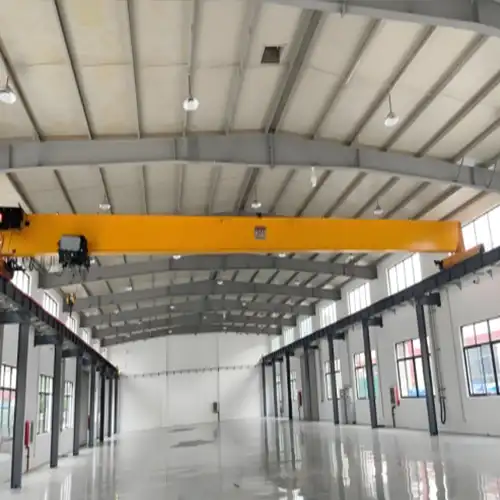
Single girder overhead crane 5 ton supported by semi freestanding runway
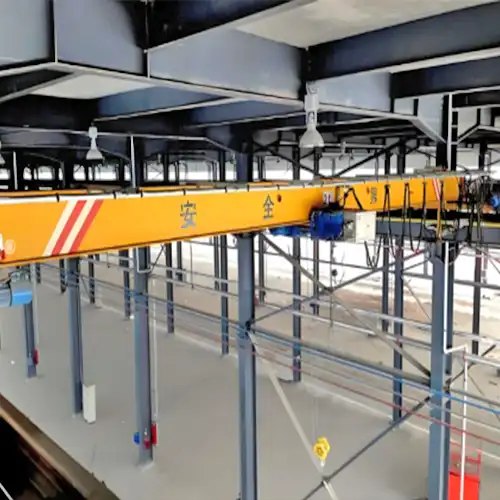
5 ton overhead crane mounted on the steel structure of steel building

Double girder overhead crane mounted on steel structure of steel workshop
Let's delve into the comparison:
Freestanding Bridge Cranes:
- Installation: Freestanding bridge cranes do not rely on existing building structures for support, allowing for easier installation without the need for extensive modifications to the building. They require a standalone support system, typically consisting of columns and runway beams, which can be installed independently of the building structure.
- Flexibility: Freestanding bridge cranes offer greater flexibility in terms of placement and relocation within the facility. They can be positioned anywhere with sufficient floor space and overhead clearance, making them suitable for both new construction projects and existing buildings where structural modifications are impractical or costly.
- Cost: While freestanding bridge cranes may require additional upfront investment for the standalone support system, they often offer cost savings in terms of installation and retrofitting compared to overhead bridge cranes mounted on steel structures. The modular design and ease of installation can reduce labor and construction costs associated with building modifications.
- Adaptability: Freestanding bridge cranes can be easily adapted to changing operational needs or facility layouts. They can accommodate various runway configurations, crane spans, and lifting capacities, allowing for customization to suit specific application requirements without the constraints of fixed building structures.
- Maintenance: Freestanding bridge cranes may require less maintenance compared to overhead bridge cranes mounted on steel structures, as they are not subject to the same wear and tear from building movement or structural shifts. Routine maintenance tasks, such as inspections, lubrication, and repairs, are typically focused on crane components rather than building structures.
Overhead Bridge Cranes Mounted on Steel Structures:
- Structural Support: Overhead bridge cranes mounted on steel structures rely on the structural integrity of the building to support the crane runway and lifting mechanism. They require careful engineering and construction to ensure compatibility with the building's design and load-bearing capacity.
- Stability: Overhead bridge cranes mounted on steel structures offer stability and rigidity, as they are securely anchored to the building framework. They are less susceptible to movement or vibration compared to freestanding cranes, providing a stable platform for lifting operations.
- Integration: Overhead bridge cranes mounted on steel structures can be integrated into the overall building design, allowing for seamless coordination with other building systems such as lighting, HVAC, and electrical wiring. They are often preferred for new construction projects where crane installation can be planned and incorporated into the building design from the outset.
- Space Utilization: Overhead bridge cranes mounted on steel structures utilize overhead space efficiently, minimizing interference with floor operations and maximizing usable floor space. They are ideal for facilities with limited floor space or where ground-level obstacles prohibit the use of freestanding cranes.
- Long-Term Investment: Overhead bridge cranes mounted on steel structures represent a long-term investment in building infrastructure, providing durable and reliable lifting solutions that can withstand the test of time. They are well-suited for applications where permanent crane installations are required and where building modifications are feasible and cost-effective.
In summary, the choice between freestanding bridge cranes and overhead bridge cranes mounted on steel structures depends on factors such as installation requirements, flexibility, cost considerations, and long-term operational needs. Both options offer distinct advantages and can be tailored to suit specific application requirements in industrial settings.
Freestanding Bridge Crane vs Overhead Bridge Cranes Mounted on the Corbel of Concrete Columns of Workshops
Comparing freestanding bridge cranes with overhead bridge cranes mounted on the corbel of concrete columns in workshops involves assessing factors such as installation, space utilization, stability, and cost considerations.
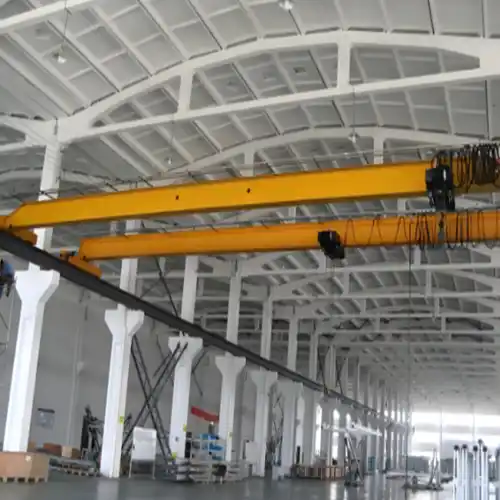
Single girder crane 5 ton installed on concrete corbel
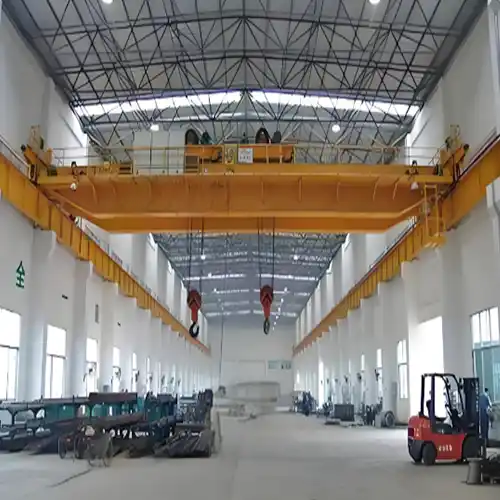
double girder crane 5 ton installed on concrete corbel
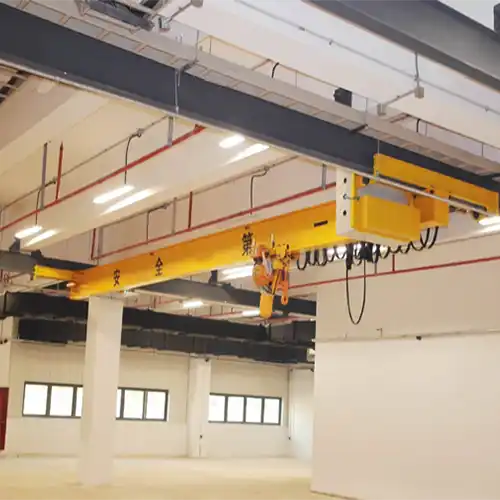
Underhung bridge crane mounted on ceiling structure of concrete workshop
Let's explore the comparison:
Freestanding Bridge Cranes:
- Installation: Freestanding bridge cranes do not require attachment to building columns or structures, offering easier installation without the need for modifications to existing concrete columns. They typically utilize standalone support systems, such as columns and runway beams, which can be installed independently of the building structure.
- Flexibility: Freestanding bridge cranes offer greater flexibility in placement and relocation within the workshop. They can be positioned anywhere with sufficient floor space and overhead clearance, making them suitable for both new construction projects and existing workshops where structural modifications are impractical or costly.
- Space Utilization: Freestanding bridge cranes maximize usable floor space within the workshop, as they do not require attachment to building columns or structures. This allows for efficient use of floor space for other activities, such as material storage, machinery, or assembly workstations.
- Stability: Freestanding bridge cranes provide stability and rigidity through their standalone support systems, which are anchored to the workshop floor. This ensures reliable performance and minimizes movement or vibration during lifting operations.
- Cost: While freestanding bridge cranes may require additional upfront investment for the standalone support system, they often offer cost savings in terms of installation and retrofitting compared to overhead bridge cranes mounted on concrete columns. The modular design and ease of installation can reduce labor and construction costs associated with building modifications.
Overhead Bridge Cranes Mounted on Concrete Column Corbels:
- Structural Attachment: Overhead bridge cranes mounted on concrete column corbels are attached directly to the building columns, utilizing reinforced concrete corbels for support. This requires careful engineering and construction to ensure compatibility with the column design and load-bearing capacity.
- Space Utilization: Overhead bridge cranes mounted on concrete column corbels utilize overhead space efficiently, minimizing interference with floor operations and maximizing usable floor space within the workshop. However, the presence of the crane runway may limit overhead space for other activities or equipment.
- Stability: Overhead bridge cranes mounted on concrete column corbels provide stability and rigidity through their attachment to the building structure. The reinforced concrete corbels offer a solid foundation for the crane runway, ensuring reliable performance and minimizing movement or vibration during lifting operations.
- Integration: Overhead bridge cranes mounted on concrete column corbels can be integrated into the workshop design, allowing for seamless coordination with other building systems. They are often preferred for new construction projects or workshops where crane installation can be planned and incorporated into the building design from the outset.
- Long-Term Investment: Overhead bridge cranes mounted on concrete column corbels represent a long-term investment in building infrastructure, providing durable and reliable lifting solutions that can withstand the test of time. They are well-suited for applications where permanent crane installations are required and where building modifications are feasible and cost-effective.
In summary, the choice between freestanding bridge cranes and overhead bridge cranes mounted on concrete column corbels depends on factors such as installation requirements, space utilization, stability, and long-term operational needs. Both options offer distinct advantages and can be tailored to suit specific application requirements in workshop environments.
Customizable Options and Configurations
Beyond the standard single and double-girder designs, 5 ton freestanding bridge cranes offer a plethora of customizable options and configurations to meet specific operational requirements. From adjustable spans and heights to specialized hoist systems and control features, these cranes can be tailored to suit the unique needs of any industrial application. Whether it's integrating safety enhancements or optimizing workflow efficiency, customization options empower businesses to maximize the utility and versatility of their crane systems.
As we delve deeper into the realm of 5 ton freestanding bridge cranes, we'll explore their diverse applications across various industrial sectors and shed light on the typical scenarios where their freestanding design proves invaluable. Let's continue our exploration of these mighty machines and uncover their myriad capabilities.
Applications in Various Industrial Sectors
- Manufacturing
In the manufacturing sector, 5 ton freestanding bridge cranes play a pivotal role in material handling, assembly, and production processes. They facilitate the movement of raw materials, components, and finished products throughout the manufacturing facility, streamlining workflow and increasing productivity. Whether it's lifting heavy machinery onto assembly lines or transferring goods between workstations, these cranes offer efficiency and precision, contributing to seamless operations in industries ranging from automotive and electronics to food and beverage. - Warehousing and Logistics
Warehousing and logistics operations rely on 5 ton freestanding bridge cranes for efficient storage, retrieval, and distribution of goods. These cranes enable the swift movement of pallets, crates, and containers within warehouses, optimizing space utilization and minimizing manual labor. From loading and unloading trucks to organizing inventory on shelves, freestanding bridge cranes enhance the speed and accuracy of warehousing operations, ensuring timely delivery and fulfillment of customer orders. - Construction
In the construction industry, 5 ton freestanding bridge cranes are indispensable for lifting and positioning heavy materials and equipment at construction sites. Whether it's hoisting steel beams, precast concrete panels, or machinery, these cranes provide the strength and stability needed to tackle demanding construction tasks. Their freestanding design allows for easy setup and mobility, making them ideal for temporary projects or sites where traditional crane infrastructure is impractical or unavailable. - Automotive Industry
The automotive industry relies on 5 ton freestanding bridge cranes for a myriad of applications, from manufacturing and assembly to maintenance and repair. These cranes are used to lift and transport vehicle components during the production process, ensuring smooth assembly and quality control. In maintenance facilities, they facilitate the servicing of vehicles by lifting engines, chassis, and other heavy parts with precision and efficiency, minimizing downtime and maximizing productivity. - Aerospace Industry
Precision and reliability are paramount in the aerospace industry, where 5 ton freestanding bridge cranes are instrumental in the manufacturing and assembly of aircraft and aerospace components. These cranes handle the lifting and maneuvering of large aircraft structures, such as fuselages and wings, as well as delicate components like engines and avionics equipment. Their ability to provide precise positioning and control ensures the integrity and safety of aerospace products throughout the production process. - Shipbuilding and Marine Industry
Shipbuilding and marine industries rely on 5 ton freestanding bridge cranes for the construction, repair, and maintenance of ships and offshore structures. These cranes handle heavy loads such as ship sections, machinery, and equipment with ease, facilitating efficient assembly and outfitting of vessels. Their robust construction and versatility make them indispensable tools in shipyards and marine facilities, where they contribute to the timely completion of projects and the seamless operation of maritime operations.
Typical Applications
- Material Handling and Assembly
- 5 ton freestanding bridge cranes excel in material handling and assembly tasks, where they are utilized to transport raw materials, components, and finished products within manufacturing facilities. These cranes facilitate the seamless movement of goods along production lines, ensuring efficient assembly processes and timely delivery of products.
- Loading and Unloading of Heavy Goods
Warehousing and logistics operations benefit from the use of 5 ton freestanding bridge cranes for loading and unloading heavy goods from trucks, containers, and storage racks. These cranes provide the lifting capacity and precision necessary to handle bulky and oversized items with ease, reducing manual labor and minimizing the risk of damage to goods. - Equipment Maintenance and Repair
In industrial settings, maintenance and repair tasks often require the lifting and positioning of heavy equipment and machinery. 5 ton freestanding bridge cranes are indispensable tools for such applications, enabling maintenance personnel to safely access and service machinery at elevated heights. Whether it's replacing components or conducting routine inspections, these cranes enhance efficiency and safety in maintenance operations. - Storage and Inventory Management
Efficient storage and inventory management are essential for optimizing warehouse operations. 5 ton freestanding bridge cranes aid in organizing and managing inventory by facilitating the movement of goods to and from storage areas. With their ability to reach elevated shelves and navigate tight spaces, these cranes contribute to maximizing storage capacity and improving inventory accuracy. - Production Line Support
5 ton freestanding bridge cranes play a crucial role in supporting production lines by providing continuous material flow and handling capabilities. Whether it's feeding raw materials into manufacturing processes or removing finished products for packaging and distribution, these cranes ensure the smooth operation of production lines, minimizing downtime and maximizing throughput.
As we delve deeper into the world of 5 ton freestanding bridge cranes, we'll explore the scenarios where their freestanding design proves invaluable and the considerations for their use in indoor and outdoor applications. Let's continue our exploration and uncover the key insights that make these cranes indispensable tools in various industrial sectors.
When Freestanding Crane Design is Required
Lack of Suitable Building Structures
In environments where traditional building structures are lacking or inadequate, the freestanding design of 5 ton bridge cranes becomes essential. Industries operating in open spaces or temporary facilities, such as construction sites or outdoor events, often require cranes that can stand independently without relying on existing structures for support.
- Open Spaces and Outdoor Events: In settings such as open fields, outdoor venues, or temporary event spaces, there's often a lack of permanent building structures to support crane installations. Freestanding bridge cranes provide a reliable solution for lifting and material handling in these environments, enabling efficient setup and operation without the need for fixed infrastructure.
- Construction Sites: Construction projects frequently require heavy lifting capabilities for tasks such as erecting steel structures, hoisting building materials, or placing equipment at elevated heights. In many cases, especially in early construction phases or remote locations, there may not be suitable building structures available to support conventional crane installations. Freestanding bridge cranes offer a versatile solution for temporary lifting needs on construction sites, allowing for efficient material handling and assembly without relying on existing buildings.
- Temporary Facilities: Industries operating in temporary facilities, such as temporary warehouses, fabrication yards, or makeshift workshops, often face challenges in integrating heavy lifting equipment due to the absence of permanent building structures. Freestanding bridge cranes provide a flexible and adaptable solution for these temporary work environments, enabling businesses to maintain productivity and efficiency without the constraints of fixed infrastructure.
- Remote or Challenging Terrain: In remote locations or areas with challenging terrain, such as mining sites, oil fields, or off-grid installations, the availability of suitable building structures for crane support may be limited or nonexistent. Freestanding bridge cranes offer a self-contained lifting solution that can be deployed in remote or rugged environments, providing essential lifting capabilities without the need for extensive groundwork or infrastructure development.
In summary, the lack of suitable building structures necessitates the use of freestanding bridge cranes in a variety of industrial settings, including open spaces, construction sites, temporary facilities, and remote or challenging terrain. These cranes offer a versatile and reliable solution for lifting and material handling needs, enabling businesses to maintain productivity and efficiency in environments where traditional crane installations are impractical or unfeasible.
Need for Flexible Placement and Mobility
Freestanding bridge cranes offer unparalleled flexibility in placement and mobility, making them ideal for dynamic industrial environments where space constraints or changing workflow layouts are common. Their portable nature allows businesses to adapt quickly to evolving operational needs without the constraints of fixed crane infrastructure.
The need for flexible placement and mobility is a crucial factor driving the popularity of freestanding bridge cranes in dynamic industrial environments. Let's explore this further:
- Dynamic Industrial Environments: In industries characterized by changing production layouts, evolving workflows, or frequent reconfigurations, the ability to quickly adapt lifting equipment to new requirements is essential. Freestanding bridge cranes offer unmatched flexibility in this regard, allowing businesses to respond rapidly to shifting operational needs without being hindered by the constraints of fixed crane infrastructure.
- Space Constraints: Many industrial facilities, particularly those operating in urban areas or within existing buildings, face space constraints that limit the installation of traditional overhead crane systems. Freestanding bridge cranes provide a compact and versatile lifting solution that can be installed in tight spaces or areas with limited overhead clearance, maximizing the use of available floor space without compromising on lifting capacity or performance.
- Portable Nature: Unlike fixed overhead crane installations, which are typically anchored to building structures, freestanding bridge cranes are inherently portable and can be easily relocated as needed. This portability allows businesses to optimize crane placement for specific tasks or production areas, minimizing downtime and streamlining workflow transitions.
- Adaptability to Changing Workflows: Industrial operations are constantly evolving to meet shifting market demands, technological advancements, or regulatory requirements. Freestanding bridge cranes enable businesses to adapt their lifting capabilities to accommodate changes in production processes, workflow layouts, or facility configurations, ensuring continued efficiency and productivity in the face of evolving operational challenges.
- Quick Installation and Setup: The modular design of freestanding bridge cranes facilitates rapid installation and setup, minimizing disruption to ongoing operations and enabling businesses to deploy lifting equipment with minimal lead time. This agility is particularly beneficial in time-sensitive projects or situations where immediate lifting capabilities are required to meet production deadlines or project milestones.
In summary, the need for flexible placement and mobility drives the widespread adoption of freestanding bridge cranes in dynamic industrial environments characterized by space constraints, changing workflows, and evolving operational needs. Their portable nature, adaptability, and quick setup make them invaluable assets for businesses seeking to optimize lifting operations and maintain agility in today's fast-paced industrial landscape.
Temporary or Portable Applications
Temporary or portable applications, such as construction projects, trade shows, or disaster relief efforts, require crane solutions that can be easily transported and set up on-site. Freestanding bridge cranes meet this demand by offering a modular design that can be assembled and disassembled with minimal effort, providing temporary lifting capabilities where needed.
- Construction Projects: Construction sites are dynamic environments where lifting requirements can vary widely throughout different phases of a project. Freestanding bridge cranes provide a versatile solution for temporary lifting needs, enabling construction crews to efficiently handle materials, equipment, and structural components at various locations on-site. Their modular design allows for quick assembly and disassembly, making them well-suited for construction projects with changing work areas or limited space for crane installations.
- Trade Shows and Events: Trade shows, exhibitions, and events often require temporary lifting capabilities for tasks such as setting up booths, staging equipment, or moving heavy displays. Freestanding bridge cranes offer a portable and adaptable solution for these temporary applications, allowing event organizers to efficiently manage logistics and ensure smooth operations without the need for permanent crane installations.
- Disaster Relief Efforts: In the aftermath of natural disasters or emergencies, rapid deployment of lifting equipment is critical for search, rescue, and recovery operations. Freestanding bridge cranes can be quickly mobilized to disaster-affected areas and set up to provide essential lifting support for debris removal, infrastructure repair, and humanitarian aid distribution. Their modular design and ease of assembly make them invaluable assets in disaster relief efforts, where time is of the essence.
- Temporary Warehousing and Storage: Temporary warehouses, storage facilities, or fabrication yards often require lifting equipment to handle incoming and outgoing goods, temporary structures, or oversized materials. Freestanding bridge cranes offer a convenient solution for these temporary applications, enabling businesses to establish efficient material handling operations without the need for permanent crane installations.
- Film and Entertainment Industry: Film sets, concert venues, and entertainment productions often require temporary lifting capabilities for rigging, stage construction, or special effects. Freestanding bridge cranes provide a portable and versatile solution for these temporary applications, allowing production crews to safely and efficiently handle equipment, scenery, and props on location.
In summary, freestanding bridge cranes are indispensable tools for temporary or portable applications where rapid deployment, versatility, and ease of setup are paramount. Their modular design, portability, and adaptability make them ideal for construction projects, trade shows, disaster relief efforts, and a variety of other temporary lifting needs across diverse industries.
Avoidance of Structural Modifications to Existing Buildings
In facilities where structural modifications are impractical or prohibitively expensive, freestanding bridge cranes offer a cost-effective alternative. By standing independently on their own support systems, these cranes eliminate the need for extensive alterations to existing buildings, preserving the integrity of the structure and minimizing downtime during installation.
- Cost-Effective Alternative: Structural modifications to existing buildings can incur significant expenses in terms of engineering assessments, construction work, and downtime. Freestanding bridge cranes offer a cost-effective alternative by eliminating the need for these modifications. Businesses can invest in the crane system itself without the additional burden of structural alterations, making it a more economical choice for lifting solutions.
- Preservation of Structural Integrity: Many industrial buildings have structural limitations or specific design considerations that make it challenging to install traditional overhead crane systems. Freestanding bridge cranes stand independently on their own support systems, bypassing the need to attach to building structures. This preserves the structural integrity of the facility and prevents potential damage or compromise to the building's framework.
- Minimization of Downtime: Structural modifications often require downtime for construction work, which can disrupt ongoing operations and affect productivity. Freestanding bridge cranes minimize downtime during installation by offering a quicker and more streamlined setup process. With minimal disruption to operations, businesses can maintain continuity in their workflow and avoid costly production delays.
- Flexibility in Installation: Freestanding bridge cranes provide flexibility in installation, allowing businesses to strategically position the crane system within their facility to optimize workflow efficiency. The modular design of these cranes facilitates easy adjustment of span lengths, heights, and other parameters to accommodate specific operational requirements. This flexibility ensures that the crane system can be tailored to suit the unique layout and needs of the facility without the constraints of fixed infrastructure.
- Scalability and Adaptability: As businesses grow or evolve, their lifting requirements may change over time. Freestanding bridge cranes offer scalability and adaptability, allowing for easy expansion or reconfiguration of the crane system as needed. Whether it's increasing lifting capacity, extending runway lengths, or adding supplementary features, these cranes can accommodate future changes in operational demands without the need for extensive structural modifications.
In summary, freestanding bridge cranes offer a cost-effective, non-invasive solution for lifting operations in facilities where structural modifications are impractical or prohibitively expensive. By preserving the integrity of existing buildings, minimizing downtime, and providing flexibility in installation, these cranes empower businesses to optimize their lifting capabilities without compromising on productivity or operational efficiency.
Considerations for Indoor and Outdoor Applications
Environmental Factors
Environmental factors play a crucial role in the performance and durability of 5 ton freestanding bridge cranes, particularly in outdoor or harsh industrial environments. Let's delve deeper into the impact of these environmental factors and the measures to mitigate their effects:
- Temperature and Humidity:
Extreme temperatures, whether hot or cold, can affect the mechanical components and electrical systems of freestanding bridge cranes. High humidity levels can exacerbate these effects by promoting corrosion and moisture accumulation. To address these challenges, proper insulation and ventilation are essential. Insulation helps regulate internal temperatures and prevent condensation, while adequate ventilation ensures airflow to dissipate heat and moisture buildup. Regular monitoring of temperature and humidity levels, along with proactive maintenance measures, can help mitigate the impact of these environmental factors on crane performance and longevity. - Corrosive Agents:
Industries operating in environments with exposure to corrosive substances, such as chemicals, saltwater, or industrial pollutants, must take proactive measures to protect their freestanding bridge cranes from corrosion-related damage. Selecting materials and coatings that are resistant to corrosion is critical for ensuring the longevity of crane components. Stainless steel, galvanized steel, and specialized corrosion-resistant coatings are commonly used to enhance the durability of crane structures and components. Additionally, regular maintenance practices, including cleaning, lubrication, and inspection, help identify and address corrosion issues before they escalate and compromise crane performance. - Exposure to Weather Elements (for Outdoor Use):
When deployed outdoors, 5 ton freestanding bridge cranes are exposed to a variety of weather elements, including rain, snow, wind, and UV radiation. These environmental factors can accelerate wear and deterioration of crane components if not properly addressed. Weatherproofing measures are essential to protect the crane from damage and ensure reliable performance in outdoor environments. Protective coatings, such as epoxy or polyurethane paints, provide a barrier against moisture and corrosion, while covers or enclosures shield sensitive electrical components from exposure to the elements. Routine inspections and maintenance checks help identify and address any weather-related issues promptly, minimizing the risk of downtime and ensuring the longevity of the crane in outdoor applications.
By understanding and addressing the impact of environmental factors, businesses can maximize the performance, reliability, and lifespan of their 5 ton freestanding bridge cranes, ensuring safe and efficient lifting operations in diverse industrial environments.
Flooring Requirements
The type and condition of the flooring where the crane will be installed play a crucial role in its stability and performance. The flooring must be able to support the weight of the crane and the loads it will be lifting. Additionally, the surface should be level and free of obstructions to ensure smooth movement of the crane along the runway. The flooring requirements for installing a 5 ton freestanding bridge crane are paramount to ensure safe and efficient operation. Let's explore the key considerations in detail:
- Rated Capacity:
The flooring must be capable of supporting the weight of the crane system, including the bridge, hoist, runway, and any loads being lifted. A structural engineer should assess the load-bearing capacity of the floor to ensure it meets the requirements specified by the crane manufacturer. This assessment takes into account factors such as the crane's dead weight, live load capacity (including the maximum rated load of the crane), and any dynamic loads during operation. - Surface Levelness:
A level surface is essential for the smooth movement of the crane along the runway. Any unevenness or irregularities in the floor can cause the crane to bind or sway during operation, leading to safety hazards and potential damage to the equipment. Prior to crane installation, the floor should be surveyed and leveled as needed to ensure uniformity and stability. Techniques such as grinding, leveling compounds, or shimming may be employed to achieve a flat and even surface. - Surface Condition:
The condition of the flooring surface is critical for maintaining traction and stability during crane operation. Smooth, clean surfaces are preferred to minimize friction and reduce wear on the crane wheels and runway rails. Any debris, oil spills, or other contaminants should be removed to prevent slip hazards and ensure optimal crane performance. In industrial environments where floor coatings or treatments are used, compatibility with crane operations should be considered to avoid damage or deterioration of the surface over time. - Obstruction-Free Path:
The runway should be free of any obstructions or obstacles that could impede the movement of the crane. Clearance zones should be established around the crane's travel path to accommodate its dimensions and prevent collisions with nearby structures, equipment, or personnel. Overhead obstructions, such as pipes, ductwork, or lighting fixtures, should be identified and cleared to provide sufficient headroom for the crane and its load. - Durability and Maintenance:
Flooring materials should be selected for their durability and resistance to wear, abrasion, and chemical exposure. Regular maintenance practices, such as cleaning, inspection, and repair of the floor surface, are essential to ensure long-term performance and safety. Any signs of damage or deterioration should be promptly addressed to prevent safety hazards and maintain the integrity of the crane installation.
By adhering to these flooring requirements, businesses can ensure the stability, performance, and safety of their 5 ton freestanding bridge cranes, enabling efficient and reliable lifting operations in industrial environments.
Clearance and Headroom
Adequate clearance and headroom are essential considerations when installing 5 ton freestanding bridge cranes. The height of the facility's ceiling or overhead obstructions must accommodate the crane's lifting height and movement. Clearances around the crane's runway and hoist path should also be sufficient to prevent collisions and ensure safe operation. Adequate clearance and headroom are critical factors to consider when installing a 5 ton freestanding bridge crane to ensure safe and efficient operation. Let's explore these considerations in more detail:
- Ceiling Height:
The height of the facility's ceiling is a primary factor in determining whether a 5 ton freestanding bridge crane can be installed. The crane's lifting height, including the hook's travel distance and any additional clearance required for lifting loads, must be accommodated within the available vertical space. It's essential to measure the vertical clearance from the floor to the lowest obstruction on the ceiling, taking into account factors such as lighting fixtures, ductwork, and structural beams. - Overhead Obstructions:
Clearances around the crane's runway and hoist path are crucial to prevent collisions with overhead obstructions during crane operation. Overhead obstructions may include existing structures, equipment, piping, or conduits that intersect with the crane's travel path. It's essential to identify and assess these obstructions to ensure they do not interfere with the crane's movement or pose safety hazards. Clearance zones should be established to provide sufficient space for the crane to maneuver safely without risk of contact with overhead obstacles. - Horizontal Clearance:
In addition to vertical clearance, horizontal clearance is also important to consider when installing a 5 ton freestanding bridge crane. The runway should be positioned to allow adequate clearance between the crane's end trucks and any adjacent walls, columns, or machinery. Sufficient horizontal clearance ensures unobstructed movement of the crane along its travel path and prevents collisions with nearby structures. - Safety Considerations:
Maintaining adequate clearance and headroom is essential for ensuring the safety of crane operators, personnel, and equipment within the facility. Insufficient clearance can increase the risk of accidents, such as collisions with overhead obstructions or entanglement hazards. It's important to adhere to safety standards and regulations governing clearance requirements for crane installations to minimize the risk of accidents and ensure compliance with industry best practices. - Customization Options:
Depending on the specific layout and constraints of the facility, customization options may be available to optimize clearance and headroom for the crane installation. Adjustable runway heights, extended runway lengths, or flexible crane configurations can be tailored to accommodate varying clearance requirements and operational needs. Working closely with crane manufacturers and engineering professionals can help identify and implement customized solutions to ensure optimal clearance and headroom for safe crane operation.
By carefully assessing and addressing clearance and headroom requirements, businesses can ensure the safe and efficient operation of their 5 ton freestanding bridge cranes, minimizing the risk of accidents and optimizing productivity in industrial environments.
Safety Measures and Regulations
Compliance with safety measures and regulations is paramount to ensure the safe operation of 5 ton freestanding bridge cranes. This includes regular inspection and maintenance of crane components, as well as adherence to safety protocols for lifting operations. Employers must provide proper training for crane operators and personnel working in proximity to the crane to minimize the risk of accidents and injuries. Ensuring the safety of operations involving 5 ton freestanding bridge cranes is a top priority for businesses. Let's delve deeper into the importance of safety measures and regulations:
- Regular Inspection and Maintenance:
Regular inspection and maintenance of crane components are essential to identify and address any potential safety hazards or mechanical issues. Routine inspections should be conducted according to manufacturer guidelines and industry standards, with a focus on critical components such as hoists, brakes, electrical systems, and structural elements. Any signs of wear, damage, or malfunction should be promptly addressed through maintenance and repair to prevent accidents and ensure the continued safe operation of the crane. - Adherence to Safety Protocols:
Adherence to safety protocols and procedures during lifting operations is crucial to minimize the risk of accidents and injuries. This includes following established safe work practices for load handling, rigging, and crane operation, as well as adhering to industry regulations and standards governing crane safety. Employers should establish clear guidelines and protocols for crane operation, including pre-operational checks, load capacity limits, and communication procedures between crane operators and ground personnel. - Proper Training and Certification:
Employers must ensure that crane operators and personnel working in proximity to the crane receive adequate training and certification to perform their duties safely and effectively. Crane operators should undergo comprehensive training programs covering crane operation, safety procedures, and emergency protocols. Additionally, personnel responsible for rigging, signaling, and supervising lifting operations should receive training on their respective roles and responsibilities to prevent accidents and promote a culture of safety in the workplace. - Risk Assessment and Hazard Identification:
Conducting risk assessments and hazard identification is essential to proactively identify potential safety hazards and mitigate risks associated with crane operations. Employers should assess factors such as site conditions, environmental hazards, load characteristics, and human factors to identify and control potential sources of risk. By identifying hazards early and implementing appropriate control measures, businesses can minimize the likelihood of accidents and ensure the safety of personnel working with or near the crane. - Continuous Improvement and Learning:
Safety is an ongoing process that requires continuous improvement and learning. Employers should encourage a culture of safety in the workplace by promoting open communication, soliciting feedback from employees, and implementing lessons learned from near-miss incidents or safety incidents. Regular safety meetings, training sessions, and reviews of incident reports can help identify areas for improvement and reinforce the importance of safety in crane operations.
By prioritizing safety measures and adhering to regulations, businesses can minimize the risk of accidents and injuries associated with 5 ton freestanding bridge cranes, creating a safer work environment for employees and ensuring compliance with industry standards.
By considering these factors for both indoor and outdoor applications, businesses can ensure the optimal performance and safety of their 5 ton freestanding bridge cranes. In the next section, we'll explore the benefits and limitations of these cranes, shedding light on their impact on industrial operations and productivity. Let's continue our exploration and uncover the key insights that drive the adoption of these versatile lifting solutions across diverse industries.
Benefits of 5 Ton Freestanding Bridge Cranes
- Flexibility in Installation and Relocation
5 ton freestanding bridge cranes offer unmatched flexibility in installation and relocation, thanks to their independent support systems. Businesses can easily reposition these cranes within their facilities or move them to new locations as operational needs evolve, without the need for extensive structural modifications. - Maximization of Floor Space
By standing independently on their own support structures, freestanding bridge cranes maximize floor space in industrial facilities. Unlike traditional overhead crane systems that require support from building structures, these cranes free up valuable floor space for other operations, storage, or workflow optimization. - Customization Options for Specific Needs
Businesses can tailor 5 ton freestanding bridge cranes to meet their specific operational requirements through a wide range of customization options. From adjustable spans and heights to specialized hoist systems and control features, these cranes can be configured to accommodate unique lifting challenges and workflow constraints. - Enhanced Productivity and Efficiency
The versatility and precision of 5 ton freestanding bridge cranes contribute to enhanced productivity and efficiency in industrial operations. These cranes enable swift and precise handling of heavy loads, reducing manual labor and minimizing downtime. With faster cycle times and smoother workflow integration, businesses can achieve higher output and throughput rates. - Safety Features and Compliance with Industry Standards
5 ton freestanding bridge cranes are equipped with advanced safety features and adhere to stringent industry standards to ensure safe operation. From overload protection and emergency stop mechanisms to comprehensive operator training programs, these cranes prioritize safety at every stage of operation. Compliance with industry regulations and standards further enhances workplace safety and minimizes the risk of accidents or injuries.
The benefits of 5 ton freestanding bridge cranes extend beyond efficiency and productivity, encompassing safety, flexibility, and customization options. In the final section, we'll explore the limitations of these cranes and summarize the key insights uncovered in our comprehensive guide. Let's conclude our exploration of these versatile lifting solutions and reflect on their impact on industrial operations.
Limitations of 5 Ton Freestanding Bridge Cranes
- Limited Load Capacity Compared to Larger Cranes
While 5 ton freestanding bridge cranes offer significant lifting capacity, they may have limitations compared to larger crane systems. In industries with heavy-duty lifting requirements, such as shipbuilding or steel manufacturing, larger cranes with higher load capacities may be more suitable for handling oversized or exceptionally heavy loads. - Higher Initial Cost for Customizations and Special Features
Customizing 5 ton freestanding bridge cranes to meet specific operational needs may incur higher initial costs compared to standard configurations. Features such as specialized hoists, control systems, or safety enhancements may require additional investment upfront. However, businesses must weigh these costs against the potential long-term benefits and improved efficiency. - Potential for Increased Maintenance Requirements
Like any mechanical equipment, 5 ton freestanding bridge cranes require regular maintenance to ensure optimal performance and safety. Freestanding cranes may have additional maintenance requirements compared to fixed crane systems, particularly in outdoor environments exposed to weather elements or corrosive agents. Routine inspections and preventive maintenance are essential to minimize downtime and prolong the lifespan of the crane. - Impact of Environmental Conditions on Performance
Environmental factors such as temperature fluctuations, humidity, and exposure to corrosive agents can affect the performance and longevity of 5 ton freestanding bridge cranes. Outdoor cranes are particularly susceptible to weather-related wear and tear, which may necessitate more frequent maintenance and inspection. Proper precautions, such as protective coatings and regular cleaning, can mitigate the impact of environmental conditions on crane performance.
Despite these limitations, freestanding cranes offer numerous benefits and can be highly effective lifting solutions when deployed in the right contexts. Let's conclude our exploration of these versatile lifting solutions and summarize the key insights uncovered in our comprehensive guide.
Conclusion
Throughout this guide, we've explored the world of 5 ton freestanding bridge cranes, uncovering their definition, components, and diverse applications across various industrial sectors. We've delved into the types, benefits, limitations, and considerations for both indoor and outdoor use of these versatile lifting solutions.
5 ton freestanding bridge cranes offer numerous advantages, including flexibility in installation and relocation, maximization of floor space, customization options, enhanced productivity and efficiency, and robust safety features. However, businesses must also consider limitations such as load capacity, initial costs, maintenance requirements, and environmental impacts when selecting these cranes for specific applications.
Selecting the right crane is crucial for optimizing efficiency, productivity, and safety in industrial operations. By understanding the unique requirements and challenges of their applications, businesses can choose the most suitable lifting solution—whether it's a 5 ton freestanding bridge crane or another type of crane—to meet their operational needs and achieve their goals effectively.
In conclusion, 5 ton freestanding bridge cranes represent a valuable asset in the arsenal of modern industrial equipment, offering versatility, efficiency, and safety in material handling and lifting operations. By leveraging their strengths and addressing potential limitations, businesses can harness the full potential of these cranes to drive success in their respective industries. If you have any need of 5 ton freestanding bridge crane, please feel free to contact us.
Main Projects
Related Products
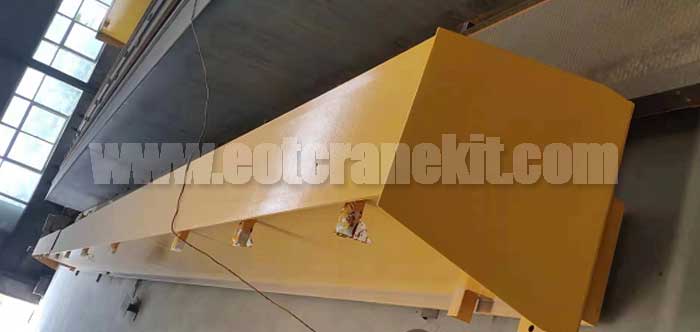
6.3 ton overhead crane kit for sale Philippines, complete single girder top running overhead crane system, low headroom design for workshop indoor use.
Free consultation to Confirm Parameters & Specifications and Get
Latest Crane Price & Crane Rate.
- Types of overhead cranes : _______?
- Optional: Overhead travelling crane, goliath gantry crane,Slewing jib crane, Single girder or double girder crane,small portable crane or kbk crane, etc.
- Capacity of overhead crane: _______?
- Optional: 0.25ton, 0.5 ton, 1 ton, 2 ton, 3ton, 5 ton, 10 ton,15ton, 20ton, 25 ton, 30ton,35ton, up to 550ton, etc.
- Crane span & lifting height : _______?
- Crane travelling length : _____?
- Control of overhead crane:_______?
- Optional: pendant/ remote/cabin control
- Voltage supply of overhead crane:_____?
- Eg,: 380V50/60HZ,3Phase or others,etc.
- Application/usage of crane:_______?
- Eg,: Steel mill, ,injection mold, cement,stone, concrete,granite, general manufacturing, etc.
Just leave a message via the contact form and our hoist and crane engineer will contact you with in 24working hours.
Get In Touch
